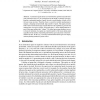Free Online Productivity Tools
i2Speak
i2Symbol
i2OCR
iTex2Img
iWeb2Print
iWeb2Shot
i2Type
iPdf2Split
iPdf2Merge
i2Bopomofo
i2Arabic
i2Style
i2Image
i2PDF
iLatex2Rtf
Sci2ools
ATAL
1995
Springer
1995
Springer
Alarms: An Implementation of Motivated Agency
Autonomousagentsin the real world must be capableof asynchronous goal generation. However, one consequence of this ability is that the agent may generate a substantial number of goals, but only a small number of these will be relevant at any one time. Therefore, there is a need for tractable mechanisms to manage a changing and potentially large number of goals. This paper presents both a framework for the design of agents that have the capability to generate and manage their own top level goals, “motivated agency”, and an implementation of part of this agent architecture, “alarms”. The alarm-processing machinery serves to focus the attention of an agent on a limited number of the most salient goals regardless of the number of possible goals that the agent can pursue or their distribution in time. In this way, a resource-bounded autonomous agent can employ modern planning methods to greater effect.
ATAL 1995 | Capableof Asynchronous Goal | Intelligent Agents | Resource-bounded Autonomous Agent | Substantial Number |
| Added | 25 Aug 2010 |
| Updated | 25 Aug 2010 |
| Type | Conference |
| Year | 1995 |
| Where | ATAL |
| Authors | Timothy J. Norman, Derek Long |
Comments (0)

